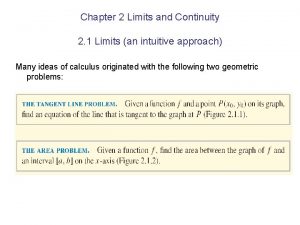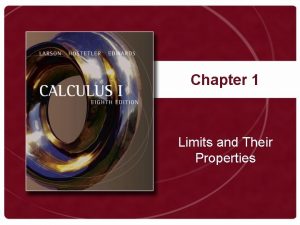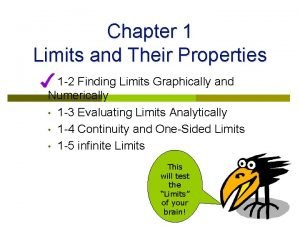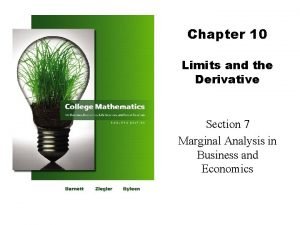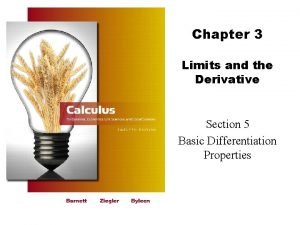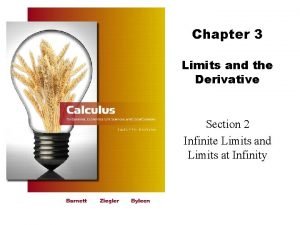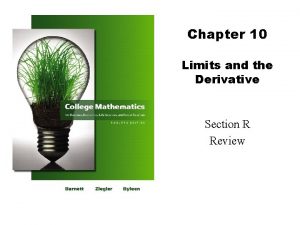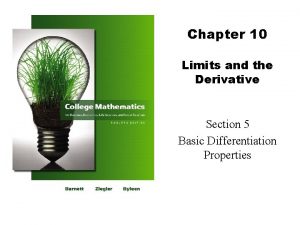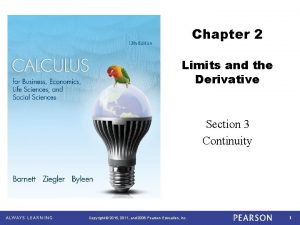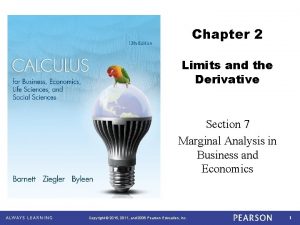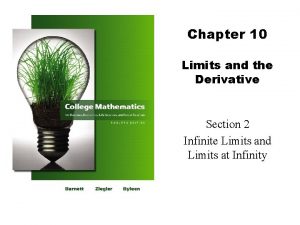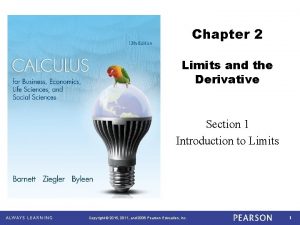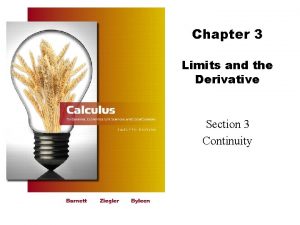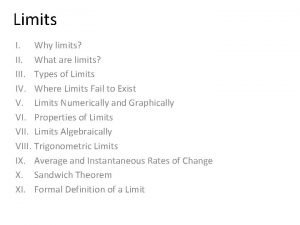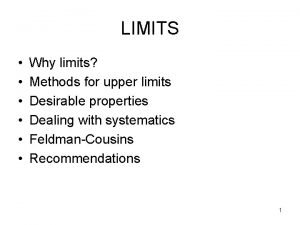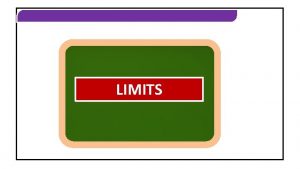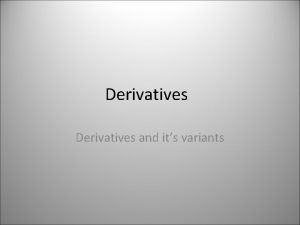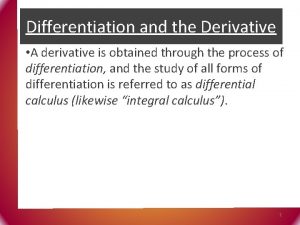Chapter 2 Limits and the Derivative Section 2


























- Slides: 26

Chapter 2 Limits and the Derivative Section 2 Basic Differentiation Properties

Calculus CHAPTER 2 SECTION 2 Barnett/Ziegler/Byleen Business Calculus 12 e 2

Objectives for Section 3. 5 Power Rule and Differentiation Properties ■ The student will be able to calculate the derivative of a constant function. ■ The student will be able to apply the power rule. ■ The student will be able to apply the constant multiple and sum and difference properties. ■ The student will be able to solve applications. Barnett/Ziegler/Byleen Business Calculus 12 e 3

Derivative Notation In the preceding section we defined the derivative of a function. There are several widely used symbols to represent the derivative. Given y = f (x), the derivative of f at x may be represented by any of the following: ■ f (x) ■ y ■ dy/dx Barnett/Ziegler/Byleen Business Calculus 12 e 4

Example 1 What is the slope of a constant function? Barnett/Ziegler/Byleen Business Calculus 12 e 5

Example 1 (continued) What is the slope of a constant function? The graph of f (x) = C is a horizontal line with slope 0, so we would expect f ’(x) = 0. Theorem 1. Let y = f (x) = C be a constant function, then y = f (x) = 0. Barnett/Ziegler/Byleen Business Calculus 12 e 6

Power Rule A function of the form f (x) = xn is called a power function. This includes f (x) = x (where n = 1) and radical functions (fractional n). Theorem 2. (Power Rule) Let y = xn be a power function, then y = f (x) = dy/dx = n xn – 1. THEOREM 2 IS VERY IMPORTANT. IT WILL BE USED A LOT! Barnett/Ziegler/Byleen Business Calculus 12 e 7

Example 2 Differentiate f (x) = x 5. Barnett/Ziegler/Byleen Business Calculus 12 e 8

Example 2 Differentiate f (x) = x 5. Solution: By the power rule, the derivative of xn is n xn– 1. In our case n = 5, so we get f (x) = 5 x 4. Barnett/Ziegler/Byleen Business Calculus 12 e 9

Example 3 Differentiate Barnett/Ziegler/Byleen Business Calculus 12 e 10

Example 3 Differentiate Solution: Rewrite f (x) as a power function, and apply the power rule: Barnett/Ziegler/Byleen Business Calculus 12 e 11

Constant Multiple Property Theorem 3. Let y = f (x) = k u(x) be a constant k times a function u(x). Then y = f (x) = k u (x). In words: The derivative of a constant times a function is the constant times the derivative of the function. Barnett/Ziegler/Byleen Business Calculus 12 e 12

Example 4 Differentiate f (x) = 7 x 4. Barnett/Ziegler/Byleen Business Calculus 12 e 13

Example 4 Differentiate f (x) = 7 x 4. Solution: Apply the constant multiple property and the power rule. f (x) = 7 (4 x 3) = 28 x 3. Barnett/Ziegler/Byleen Business Calculus 12 e 14

Sum and Difference Properties Theorem 5. If y = f (x) = u(x) ± v(x), then y = f (x) = u (x) ± v (x). In words: ■ The derivative of the sum of two differentiable functions is the sum of the derivatives. ■ The derivative of the difference of two differentiable functions is the difference of the derivatives. Barnett/Ziegler/Byleen Business Calculus 12 e 15

Example 5 Differentiate f (x) = 3 x 5 + x 4 – 2 x 3 + 5 x 2 – 7 x + 4. Barnett/Ziegler/Byleen Business Calculus 12 e 16

Example 5 Differentiate f (x) = 3 x 5 + x 4 – 2 x 3 + 5 x 2 – 7 x + 4. Solution: Apply the sum and difference rules, as well as the constant multiple property and the power rule. f (x) = 15 x 4 + 4 x 3 – 6 x 2 + 10 x – 7. Barnett/Ziegler/Byleen Business Calculus 12 e 17

Applications Remember that the derivative gives the instantaneous rate of change of the function with respect to x. That might be: ■ Instantaneous velocity. ■ Tangent line slope at a point on the curve of the function. ■ Marginal Cost. If C(x) is the cost function, that is, the total cost of producing x items, then C (x) approximates the cost of producing one more item at a production level of x items. C (x) is called the marginal cost. Barnett/Ziegler/Byleen Business Calculus 12 e 18

Tangent Line Example Let f (x) = x 4 – 6 x 2 + 10. (a) Find f (x) (b) Find the equation of the tangent line at x = 1 Barnett/Ziegler/Byleen Business Calculus 12 e 19

Tangent Line Example (continued) Let f (x) = x 4 – 6 x 2 + 10. (a) Find f (x) (b) Find the equation of the tangent line at x = 1 Solution: • f (x) = 4 x 3 - 12 x • Slope: f (1) = 4(13) – 12(1) = -8. Point: If x = 1, then y = f (1) = 1 – 6 + 10 = 5. Point-slope form: y – y 1 = m(x – x 1) y – 5 = – 8(x – 1) y = – 8 x + 13 Barnett/Ziegler/Byleen Business Calculus 12 e 20

Application Example The total cost (in dollars) of producing x portable radios per day is C(x) = 1000 + 100 x – 0. 5 x 2 for 0 ≤ x ≤ 100. 1. Find the marginal cost at a production level of x radios. Barnett/Ziegler/Byleen Business Calculus 12 e 21

Example (continued) The total cost (in dollars) of producing x portable radios per day is C(x) = 1000 + 100 x – 0. 5 x 2 for 0 ≤ x ≤ 100. 1. Find the marginal cost at a production level of x radios. Solution: The marginal cost will be C (x) = 100 – x. Barnett/Ziegler/Byleen Business Calculus 12 e 22

Example (continued) 2. Find the marginal cost at a production level of 80 radios and interpret the result. Barnett/Ziegler/Byleen Business Calculus 12 e 23

Example (continued) 2. Find the marginal cost at a production level of 80 radios and interpret the result. Solution: C (80) = 100 – 80 = 20. It will cost approximately $20 to produce the 81 st radio. 3. Find the actual cost of producing the 81 st radio and compare this with the marginal cost. Barnett/Ziegler/Byleen Business Calculus 12 e 24

Example (continued) 2. Find the marginal cost at a production level of 80 radios and interpret the result. Solution: C (80) = 100 – 80 = 20. It will cost approximately $20 to produce the 81 st radio. 3. Find the actual cost of producing the 81 st radio and compare this with the marginal cost. Solution: The actual cost of the 81 st radio will be C(81) – C(80) = $5819. 50 – $5800 = $19. 50. 2. This is approximately equal to the marginal cost. Barnett/Ziegler/Byleen Business Calculus 12 e 25

Summary § If f (x) = C, then f (x) = 0 § If f (x) = xn, then f (x) = n xn-1 § If f (x) = k u(x), then f (x) = k u (x) § If f (x) = u(x) ± v(x), then f (x) = u (x) ± v (x). Barnett/Ziegler/Byleen Business Calculus 12 e 26
 Lim as x approaches infinity
Lim as x approaches infinity Shape 65
Shape 65 China limits european contacts
China limits european contacts Chapter 21 section 5 parliament limits the english monarchy
Chapter 21 section 5 parliament limits the english monarchy How did hongwu bring stability to china
How did hongwu bring stability to china Parliament limits the english monarchy
Parliament limits the english monarchy When do density dependent factors operate most strongly
When do density dependent factors operate most strongly Limits
Limits Limits and their properties
Limits and their properties Chapter 1 limits and their properties
Chapter 1 limits and their properties Limit of trigonometric functions examples
Limit of trigonometric functions examples Economizing problem definition
Economizing problem definition Chapter 10 section 1: meiosis
Chapter 10 section 1: meiosis Hình ảnh bộ gõ cơ thể búng tay
Hình ảnh bộ gõ cơ thể búng tay Lp html
Lp html Bổ thể
Bổ thể Tỉ lệ cơ thể trẻ em
Tỉ lệ cơ thể trẻ em Gấu đi như thế nào
Gấu đi như thế nào Glasgow thang điểm
Glasgow thang điểm Chúa yêu trần thế alleluia
Chúa yêu trần thế alleluia Các môn thể thao bắt đầu bằng tiếng đua
Các môn thể thao bắt đầu bằng tiếng đua Thế nào là hệ số cao nhất
Thế nào là hệ số cao nhất Các châu lục và đại dương trên thế giới
Các châu lục và đại dương trên thế giới Công của trọng lực
Công của trọng lực Trời xanh đây là của chúng ta thể thơ
Trời xanh đây là của chúng ta thể thơ Cách giải mật thư tọa độ
Cách giải mật thư tọa độ Làm thế nào để 102-1=99
Làm thế nào để 102-1=99







